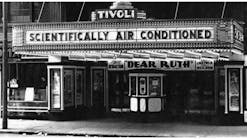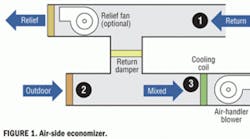Constant-volume air-conditioning systems control space air temperature directly and humidity indirectly by modulating or cycling the cooling apparatus. This article examines the effect of economizer operation on the comfort of spaces served by constant-volume air-conditioning systems.
As they relate to integrated operation, the ideas presented here are applicable primarily to direct-expansion (DX) systems with limited unloading capability; however, many also apply to chilled-water systems. Two hypothetical cases are considered: an office building and a church sanctuary, the latter of which will be discussed next month, in Part 2 of this article.
Background
ANSI/ASHRAE/IESNA Standard 90.1-2010, Energy Standard for Buildings Except Low-Rise Residential Buildings, establishes eight climate zones, numbered 1 through 8, and a number of sub-zones designated with appended letters, such as 2B, 4C, etc. The 2007 version of the standard mandates economizers in all zones except 1A, 2A, 3A, and 4A, which basically are all of the counties east of the Mississippi River and south of the Mason-Dixon line plus western Louisiana and southeastern Texas. (Appendix B of the standard lists the climate zones for every state and county in the United States.) The recently released 2010 version of the standard removes zones 2A, 3A, and 4A from the exemption, leaving only Zone 1A. In all zones, systems under 58,000-Btuh capacity are exempt.
Figure 1 is a schematic representation of an air-side economizer. The outdoor-air and relief dampers are sized to pass the full required cooling supply airflow, while the return damper is sized to provide the supply airflow less the airflow required for space pressurization. When the zone requires heat or outdoor conditions are warm and humid, the relief damper is fully closed, the return damper is open, and the outdoor-air damper is fixed in the minimum-ventilation position, as established by ANSI/ASHRAE Standard 62.1-2010, Ventilation for Acceptable Indoor Air Quality, and building-pressurization requirements. If the zone requires cooling and outdoor air is cool and dry, the economizer can modulate the outdoor, return, and relief dampers to provide all of the cooling needed or to lessen the cooling load when the mechanical cooling system and the economizer operate concurrently. The circled numbers in Figure 1 relate to state points plotted on the psychrometric charts presented in this article.
Operation and Control
Standard 90.1 prescribes a limited number of high-limit controls: fixed dry bulb, differential dry bulb, fixed enthalpy, electronic enthalpy, differential enthalpy, and dew point/dry bulb. Each defines an outdoor temperature/humidity condition below which "free" cooling using outdoor air is enabled.
Figure 2 is a graphic representation of an economizer cooling cycle. At some low cooling loads, when outdoor conditions permit economizer operation, all cooling can be provided with the outdoor-air damper in the minimum-ventilation position, the return damper fully open, and the relief damper closed. As cooling load increases, the outdoor-air damper modulates open to maintain the space-temperature cooling set point, the relief damper modulates open to maintain constant zone positive pressure, and the return damper modulates to maintain constant supply airflow. Eventually, cooling load increases to the point the return damper closes, and all zone airflow is supplied through the outdoor-air damper.
As cooling load continues to increase, Standard 90.1-2010 mandates "integrated" economizer operation, with the outdoor-air damper fully open (providing all supply air) and the zone cooling system modulating or cycling to maintain the space-temperature set point. This mode of operation continues until outdoor conditions exceed the high-limit set point, when dampers return to "normal" cooling operation: outdoor-air damper in minimum-ventilation position, relief damper closed, and return damper open. (Note that Standard 90.1-2007 mandates integrated economizer operation only in zones 2B, 3B, 3C, 4B, and 4C, and some jurisdictions may continue to allow the 2007 exemptions.) There are problems with integrated operation when cooling is provided by systems with limited unloading capability, as will be discussed later in this article.
The object of the mandatory economizer requirement is, of course, to save energy without causing discomfort in occupied spaces. All allowed high-limit-control methods are assumed capable of achieving space design temperature. However, as will be shown, certain allowed high-limit-control methods can result in space relative humidity exceeding base design, which usually is between 50 and 60 percent. Thus, psychrometric analysis of a chosen economizer high limit is essential.
The control schemes examined for the office and church-sanctuary examples are fixed dry bulb, electronic enthalpy, and dew point/dry bulb. Both buildings are located in Minneapolis. Minneapolis was chosen because it is in a climate zone (6A) with relatively moist conditions, but no extremely hot days.
Office Example
Figure 3 is a psychrometric chart of the office operating at its air-conditioning design point. A 5-ton air-conditioning unit is operating with a supply airflow of 2,000 cfm and an outdoor airflow of 330 cfm at design outdoor conditions of 91°F DB and 73.5°F WB—Point 2 on the chart. The design room condition is Point 1: 76°F DB and 50-percent RH. The coil entering conditions are Point 3. The process line, Point 1 to Point 1A, represents the room sensible and total air-conditioning load at the design condition and airflow. The process line from Point 3 to Point 4 represents the cooling and dehumidification of supply air as it passes through the evaporator coil. Point 4 is the state point of the cooling/dehumidifying air being delivered to the room air diffusers. Because supply air follows the slope of the room process line (Point 1A to Point 1) as it picks up heat and moisture, Point 4 must be at a lower dew point and dry-bulb temperature than Point 1A. If Point 4 is at a higher dew point and dry-bulb temperature than Point 1A, the system will not hold the desired design condition, and the room will be warmer and more humid than Point 1.
The points plotted in Figure 3 correspond to the circled numbers in Figure 1. Table 1 lists the important psychrometric parameters of each state point. Point 1, the return, has the same state conditions as the occupied spaces, except for return airflow, which is lower than supply airflow (Point 4) because a portion is exhausted or leaks from the building.
Economizer-system selection and specification takes place after an air-conditioning system is selected based on design conditions. Thus, psychrometric analysis of cooling-system design point is the first step in analyzing economizer operation and selecting high-limit controls. Room (occupied space) cooling loads at the outdoor conditions at which an economizer will operate then must be determined. Integrated operation requires that the sensible and latent capacity of a cooling system be determined from manufacturer data for the most extreme outdoor-air conditions.
Figure 4 shows the room process line for two cool, dry days in late September or October. No outdoor-air temperature higher than the one at Point 1A can satisfy the design space temperature without mechanical refrigeration supplement, while no outdoor-air state point above the room process line going from Point 1 to Point 1A can satisfy the design room humidity ratio without mechanical refrigeration supplement. The light-blue lines in Figure 4 show the Climate Zone 6A minimums for fixed-dry-bulb and enthalpy control.
In the case of Point 2, 50°F outdoor air is blended with return air for delivery of mixed air at Point 3, the temperature needed to achieve the design room set point. Point 1" is the room condition reached with supply air at Point 3. As outdoor-air temperature rises, economizer flow increases, and return airflow decreases until, at Point 2', outdoor-air temperature is the same as the required supply-air temperature (Point 1A), and supply air is 100-percent outdoor air. (Point 1' on the gray process line shows the room condition that will occur with the economizer operating with 100-percent outdoor air at Point 2'.) Going in the other direction, as outdoor air cools, the outdoor-air damper, responding to room temperature, closes more and more, until only minimum outdoor air blended with return air is needed to meet the cooling load. The outdoor-air damper is in minimum-ventilation position, and the relief damper is fully closed. The system basically is back to "normal" operation, as room temperature falls through the dead band to the heating set point.
Note that in Figure 4, Point 1A is at a higher dry-bulb temperature than it is in Figure 3, the design condition. This is attributable to reduced envelope loads at cooler outdoor temperatures.
Figure 5 shows the office of Figure 3 operating under integrated economizer control at an outdoor temperature of 61°F and 90-percent RH, not unusual for Minneapolis in late September. Because operation is integrated, Point 2 is the condition of the inlet to the DX coil. The leaving state point of the 5-ton evaporator coil, assuming a single-stage compressor, is represented by Point 4.i
Air supplied to the diffusers at the conditions of Point 1A will satisfy the design room conditions of 76°F and 50-percent RH. Because the air entering at Point 4 is cooler and dryer than the air entering at Point 1A, the single-stage air-conditioning-unit compressor will cycle as needed to maintain the room set point. During off times, the relatively moist air of Point 2 will be brought into the building, raising its humidity, as represented by the gray process line and Point 1’. While the moisture gain caused by cycling is difficult to quantify and dependent on the part-load capabilities of the air-conditioning unit, it can be seen that as the outdoor condition moves to warmer, more-humid state points, off times may exacerbate the room-humidity increase, especially under extremely humid conditions. To avoid this, the engineer could choose a dry-bulb/dew-point limit, such as that indicated by the light-blue lines in Figure 5. Also effective would be the electronic enthalpy "A" curve allowed by Standard 90.1-2010 and explained below.
Point 4 in Figure 5 shows a supply-air temperature below 50°F. Such a low temperature could cause problems, such as condensation on diffusers, large temperature swings, and cold drafts. These can occur even with capacity modulation, if the lowest level of capacity greatly exceeds the cooling load. If psychrometric analysis shows this is possible, a control solution is to set a minimum supply-air temperature. When supply-air temperature falls below the set point, the outdoor-air damper closes and the return-air damper opens. "False loading" reduces cycling and associated humidity and comfort issues, but at some loss in energy saving because the economizer is not fully integrated.
Good practice for integrated-economizer design is to specify a unit or units with two or more speeds or stages, a variable-speed or variable-capacity unit, or multiple condensing units with a face-split evaporator. Two-stage and multispeed compressors as small as 5 tons are available.
The red triangles in Figure 5 represent the "A" curve of an electronic enthalpy module,1 one of the economizer limits permitted by Standard 90.1-2010. Used on many packaged air-conditioning units, this has the advantage of being a single pre-engineered module. The dry-bulb/dew-point limit is implemented most easily as part of a direct-digital-control system.
Note
i) Coil performance was extrapolated from 75°F-condenser-air and 80°F-entering-air data using curve fit.
Reference
1) Honeywell. (1997). H705A solid state enthalpy controller (p. 8). Retrieved from http://customer.honeywell.com/techlit/pdf/PackedLit/63-2144.pdf
TO READ PART 2 OF THIS ARTICLE, CLICK HERE.
Fred W. Dougherty, PE, BAE, MME, is a consulting engineer with more than 30 years of experience designing building mechanical systems, including HVAC, plumbing, and fire protection. Currently, he works independently designing HVAC systems for small commercial and institutional projects. He can be contacted at [email protected].
Did you find this article useful? Send comments and suggestions to Executive Editor Scott Arnold at [email protected].









